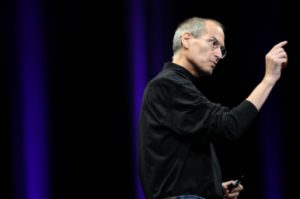Creativity and Health
- 09
- Feb

The late Steven Jobs could have used pure frankincense, geranium, or orange essential oil, but his company, Apple, might not be the same….
Mental and physical health are known to affect productivity, but how creativity is affected is less appreciated. Allusions to extreme mental instability, madness, and creativity, have been made and are almost a meme.
In grade school you may recall we were taught about the madness of the painter Vincent Van Gogh, which led him to eventually cut off his ear. Talk about paying dues to become world-famous.
Pulling back a bit and looking at the emotions that precede extreme instability, anger stands out and its relationship to spurts of creativity is clear.
Wired magazine describes the “Creativity of Anger” in an article about Steven Jobs and how he often unleashed venom on staff who didn’t perform as he expected. In so doing he created arguably the most creative company in the world. Jobs was,
“blunt at all costs, a cultural habit that has permeated the company. Jonathan Ive, the lead designer at Apple, describes the tenor of group meetings as ‘brutally critical.’ “
In refusing to hide his disappointment and displeasure, Jobs always spurred creativity. (full article link below)
What does this mean for your health? Certainly anger is not a cure-all, and nastiness isn’t always smart, the article states. For one thing, both can be exhausting and “resource depleting.” For example, “Although angry subjects initially generated more ideas, their performance quickly declined. By the end of the idea-generation session, they were performing at roughly the same level as everyone else,” the articles says.
Anger can propel you to take actions that are more creative than you would be normally take.
The article cites a study by Module Akinola, “The Dark Side of Creativity,” which corroborates the notion of negative emotions jumpstarting creativity.
“The setup was very clever [sic]: she asked subjects to give a short speech about their dream job. The students were randomly assigned to either a positive or negative feedback condition, in which their speech was greeted with smiles and vertical nods (positive) or frowns and horizontal shakes (negative). After the speech was over, the subjects were given glue, paper and colored felt and told to make a collage using the materials. Professional artists then evaluated each collage according to various metrics of creativity.
“Not surprisingly, the feedback impacted the mood of the subjects: Those who received smiles during their speeches reported feeling better than before, while frowns had the opposite effect. What’s interesting is what happened next: Subjects in the negative feedback condition created much prettier collages. Their angst led to better art. As Akinola notes, this is largely because the sadness improved their focus, and made them more likely to persist with the creative challenge:
‘Previous research has shown that negative feedback can lead to increased subsequent effort, as long as the task is not perceived as too difficult to be mastered (Locke & Latham, 1990). This is consistent with research indicating that when individuals experience negative affect in a situation that requires creativity, this negative affect may be interpreted as a signal that additional effort must be exerted for a creative solution to be discovered. In contrast, positive mood coupled with a situation that requires creativity may be an indication that the creative goal has been met, reducing the amount of effort exerted on the task.’ ” (emphasis added)
Note that “better art” and creative solutions were produced when people felt disrespected. This is a critically important observation for people who have felt disrespected all of their lives.
Holistic health means taking all aspects of the self –feelings such as disrespect, moods, emotions, physical health and spiritual beliefs– into consideration.
We are used to thinking of health as individual in nature, but as the example of Jobs shows, one’s state of mind greatly influences associations, in his case, his company. Akinola’s study shows that negativity can bring about strong positivity in the form of increased creativity in pursuing a goal.
Taking these ideas together, brainstorming for health solutions can be used to bring out hidden aspects of a health problem that one person cannot see.
This management technique just may be the answer for those facing serious health challenges. In other words, don’t just get a second opinion, call a family meeting, an ndaba (great sitting down) to make life-changing decisions.
One person doesn’t have all the answers, and if you think of the brilliant, creative, productive and introverted families and friends in your life network, involve them in a major healthy life decision appears as a wise decision. Okay, most of them….
AND, people should be given free rein to suggest crazy ideas that they might normally be chastised for.
Brainstorming about your health is a creative way to address thorny issues and another reason to come together with family and friends. Everything we need is in the circle.
–Rev. Niamo Nancy Muid
Read the entire article here:
https://www.wired.com/2011/08/the-creativity-of-anger/
- Niamo Muid
- Articles & News
- Tagged with : anger, brainstorming, holistic health, mental clarity, negativity
- No Comments





